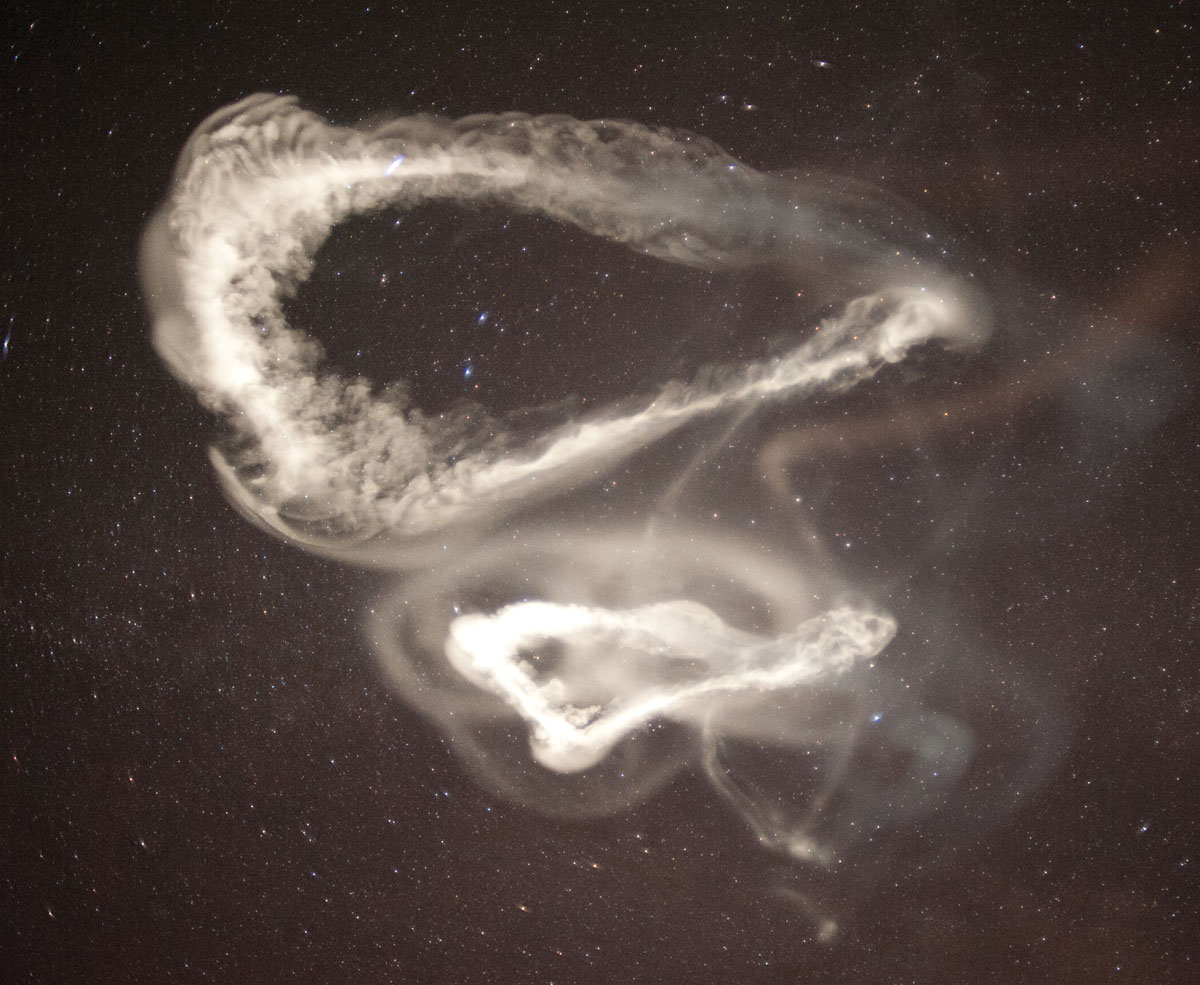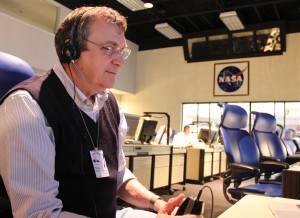Probing a mystery at the edge of space
Taylor Reeves
On a clear night in March, five rockets pierce the sky above the coast of Virginia. As the roar of their departure fades, they grow ever smaller and disappear into darkness. Seconds later, streaks of glowing white clouds spiral downward. Monitored by cameras in New Jersey, Virginia, and North Carolina, these chemical tracers reveal patterns of winds and turbulence at the edge of space.
By tracking the clouds’ movement, physicists Miguel Larsen and Gerald Lehmacher can analyze a high-altitude jet stream approximately sixty-five miles above Earth’s surface. Because this jet stream lies at an altitude in which the atmosphere should become relatively calm, its presence and strength present an enigma. In 2002, after reviewing previous experiments on upper atmospheric winds, Larsen noticed that winds in this upper jet stream were three to four times stronger than theory predicted.
“From the experiment history, it was clear that there was a pattern,” he says. “These winds were persistent, ubiquitous, and faster than they were supposed to be. We wanted to find out why.”
The Anomalous Transport Rocket Experiment (ATREX) provided an opportunity to closely monitor these winds and track their growth patterns. At the NASA Wallops Flight Facility near Chincoteague, Virginia, scientists equipped five sounding rockets, each approximately ten meters long and four teen to seventeen inches in diameter, with payloads of trimethyl aluminum (TMA), a chemical that glows when it interacts with oxygen. The rockets were launched approximately eighty seconds apart, and each emitted a stream of TMA on its ascent and descent. Scientists at vantage points in three different states photographed the spiral patterns formed by these emissions.
Lehmacher also outfitted two of the rockets with instruments to measure the density and temperature of the atmosphere. Larsen, Lehmacher, and a team of roughly sixty NASA engineers designed the rockets, each equipped for payloads of three hundred to six hundred pounds, so that they would spin at five revolutions per second to make their flight more stable. Several of the rockets also had gas jet systems to control the rocket orientation and optimize measurements. Data generated by the ATREX experiment are well worth long hours of preparation, as the atmospheric regions at the edge of space reveal a lot about planetary atmospheres throughout the solar system and satellite communications here on Earth. To understand why, it helps to know how the atmosphere stacks up.

Sixty-five miles above the Earth, a ghostly swirl of chemicals reveals a mysterious current of air. Image by Miguel Larsen.
Mixing it up
The high-altitude jet stream occupies an atmospheric region called the turbopause, which lies roughly sixty miles above the Earth’s surface and marks the boundary between the well-mixed lower atmosphere and the heterogeneous upper atmosphere. The troposphere, stratosphere, and mesosphere lie below the turbopause. High levels of turbulence in these regions allow atmospheric chemicals to remain well mixed.
Above the turbopause, the atmosphere becomes too thin for this mixing to occur, and chemical compositions begin to vary. The atmosphere becomes thinner and presumably calmer as altitude increases, since large wave motions cancel each other out. Because of this, the strong winds of the high-altitude jet stream defy scientific expectations.
Scientists will compare the high-altitude jet stream with a lower stream that is a well-known feature of daily weather patterns and is often cited in weather reports. The ATREX launches will determine whether the turbulence that occurs at the upper jet stream is more two-dimensional or three-dimensional. Characterized by a progression from large- to small-scale motion, three-dimensional turbulence occurs in natural phenomena such as oceanic waves. Large-scale waves gradually break down and eventually dissipate. Conversely, two-dimensional turbulence occurs when small eddies coalesce and eventually become large-scale currents. Two-dimensional turbulence produces the lower-altitude weather jet stream, and scientists hope to discover through the ATREX experiment if the upper jet stream behaves in a similar way.

Miguel Larsen looks on as the rockets make their ascent. Image courtesy of Keith Koehler / NASA Wallops Flight Facility.
Turbulence aloft
The high-altitude jet stream lies within the ionosphere, an electrically charged region of the upper atmosphere where electrical turbulence occurs. While this turbulence does not affect Earth’s surface, it can disrupt satellite and radio communications. The ATREX experiment and subsequent tests will allow scientists a better understanding of the ionosphere’s weather and will help mitigate the effects of this kind of turbulence.
Because the ATREX experiment monitors the part of the atmosphere where space begins, its results can be used to better understand the general behavior of other planetary atmospheres, such as those of Jupiter, Mars, and Venus. For example, each of Jupiter’s stripes represents a high-speed current in the planet’s atmosphere. While Jupiter’s currents are oriented on an east-west direction, Earth’s jet stream meanders from north to south as well as laterally. These differences reveal variations in the planets’ rotations and can illustrate general principles of atmospheric motion for different planets.

Spiral patterns created by the rockets’ payloads allow scientists to monitor the movement of a upper-atmospheric jet stream. Image by Miguel Larsen.
“While there are many practical aspects to this experiment, our biggest question at this point is why this jet stream is there,” Larsen says. “We don’t have a complete answer to that yet, but an understanding of these winds will help us discover a lot about our own and other planets’ atmospheres.”
To aid in this understanding, Lehmacher is collaborating with mechanical engineers to create numerical models of the upper atmospheric wind patterns observed in the ATREX experiment. These models will demonstrate the behavior of the jet stream and also help predict what happens above it.
Larsen, Lehmacher, and their team will assess the results of the ATREX experiment throughout the summer, fall, and spring before determining if follow-up experiments are necessary. They would begin planning these experiments in the summer of 2013.
“Our overall focus is on the classical understanding of how our atmosphere works,” Lehmacher says. “We are still discovering the natural processes of our world, and that kind of knowledge generation is exciting because it connects physical theory with dynamics at the edge of space.”

The ATREX rockets were about ten meters long, with payloads carefully balanced for stability. Image courtesy of Keith Koehler / NASA Wallops Flight Facility.
Miguel Larsen is a professor of physics, and Gerald Lehmacher is an associate professor of physics, in the Department of Physics and Astronomy of the College of Engineering and Science. This research was funded by the National Aeronautics and Space Administration.



